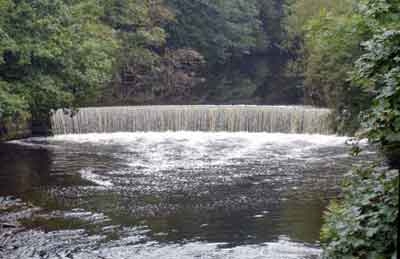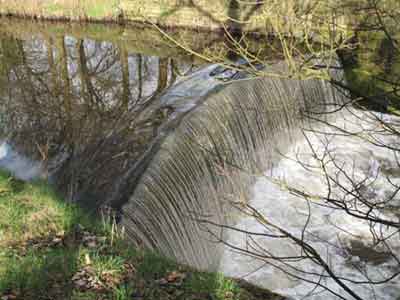
A weir is an overflow-type dam used to raise the water level of a river or stream. A substantial number of weirs were constructed during the period of the Industrial Revolution to hold back water in rivers and where necessary reservoirs, called millponds or milldams, were constructed alongside rivers. The impounded water in a river or reservoir was then used to power a mill such as a corn mill, cotton mill or woollen mill.
The construction of a weir increased the head of water (hydrostatic head), which is the vertical distance between the water level in the river or millpond and the waterwheel or turbine used to generate hydropower.
A millrace is a water channel cut for the purpose of conducting water to or from a device, such as a waterwheel or turbine, for the purpose of producing power. The channel above the device is the 'headrace' and the channel below it is the 'tailrace'.
Many weirs were built across rivers and streams of the Pennine Hills most of which have survived even though the mills that they once powered have long since disappeared. Three notable weirs in close proximity to each on the river Tame in the vicinity of Denton and Haughton are; Gibraltar Mill Weir, Haughton Dale Mill Weir and Arden Mill Weir.
Gibraltar Mill Weir
This was built to power Gibraltar Mill, which was a cotton mill built on the left bank of the river Tame in Apethorn, Hyde, between Apethorn and Haughton Dale.
It was built in the late 18th century and it was demolished in the 1960s.

Gibraltar Mill Weir, Sep 2008.
Haughton Dale Mill Weir
This was probably built in the late 18th century to power Haughton Dale Mill, which was a cotton mill built alongside the right bank of the river Tame
at the downstream end of a wide loop in the river. The weir was built across the river just below the start of the loop and the headrace was cut from above the weir directly across the loop to the mill.

Haughton Dale Mill Weir, Mar 2009.
At some point, said to be in 1853 (Middleton 1936), there was a change of use of the mill when James Walton (1802-5 Nov 1883), trading as James Walton & Sons, adapted them as Haughton Dale Wireworks. This business specialised in wiredrawing and making cards, the latter being wire combs used to straighten the fibres of raw cotton and wool prior to the spinning process. However, the date of 1853 for the establishment of this business must be contrasted with company advertisements that put the year of establishment as 1814. In this case Isaac Walton, father of James Walton, who was a merchant, founded the business. James Walton was born in Stubbin or Somerby, Yorkshire. This business closed on the 12 Mar 1903 and by 1936 the mill had been demolished.
Arden Mill Weir
This was built to power Arden Mill, which was built as a corn mill on the left bank of the river Tame in Bredbury. The present weir is the second one to be built, the earlier one, of which there is now no trace,
being built closer to the mill. The date of construction of the mill is uncertain. It probably dates from the late 18th century and it was certainly extant by 1812. Later, it became a paper mill and during the Great War (1914/18) the government requisitioned
it for the manufacture of gun cotton. However, before production had properly commenced an accident occurred that resulted in an explosion that destroyed the mill.

Arden Mill Weir, Mar 2009.